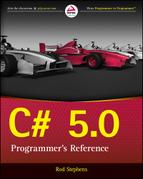Appendix I
Error Handling
A program can use try-catch-finally blocks to protect itself from exceptions. The syntax is as follows.
try
{
tryStatements...
}
catch (exceptionType1 variable1)
{
exceptionStatements1...
}
catch (exceptionType2 variable2)
{
exceptionStatements2...
}
...
catch
{
finalExceptionStatements...
}
finally
{
finallyStatements...
}When an error occurs, the program examines the catch statements in order until it finds one that matches the current exception and executes the corresponding code. If the exception doesn’t match any of the catch statements, the program executes the code in the final catch statement, which doesn’t specify an exception type.
After executing the code in the try section and possibly a catch section, the program executes the code in the finally section.
The catch and finally sections are optional; although, the try-catch-finally block must include at least one catch section or the finally section.
Throwing Exceptions
Use the throw statement to throw an exception, as in the following code.
throw new ArgumentException("Width must be greater than zero");Exception classes provide several overloaded constructors, so you can indicate such things as the basic error message, the name of the variable that caused the exception, and an inner exception.
For information on useful exception classes and custom exception classes, see Appendix O, “Useful Exception Classes.”
